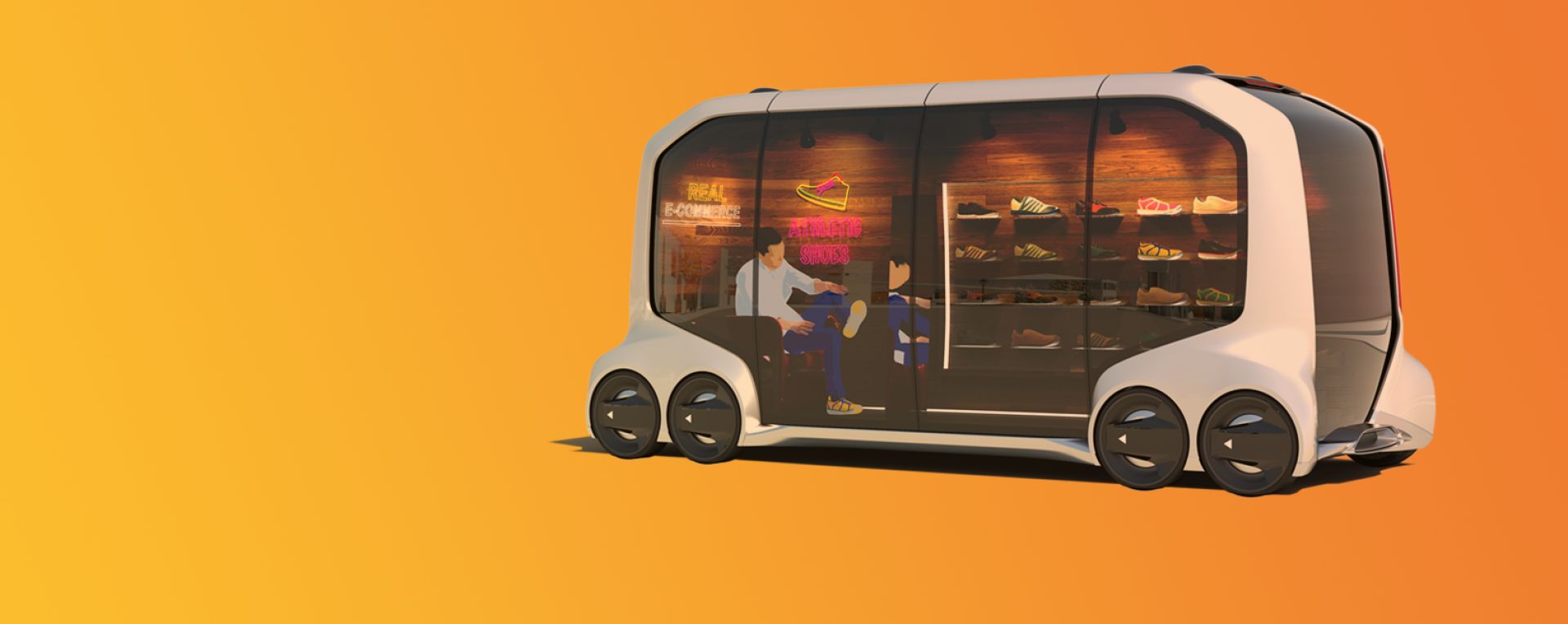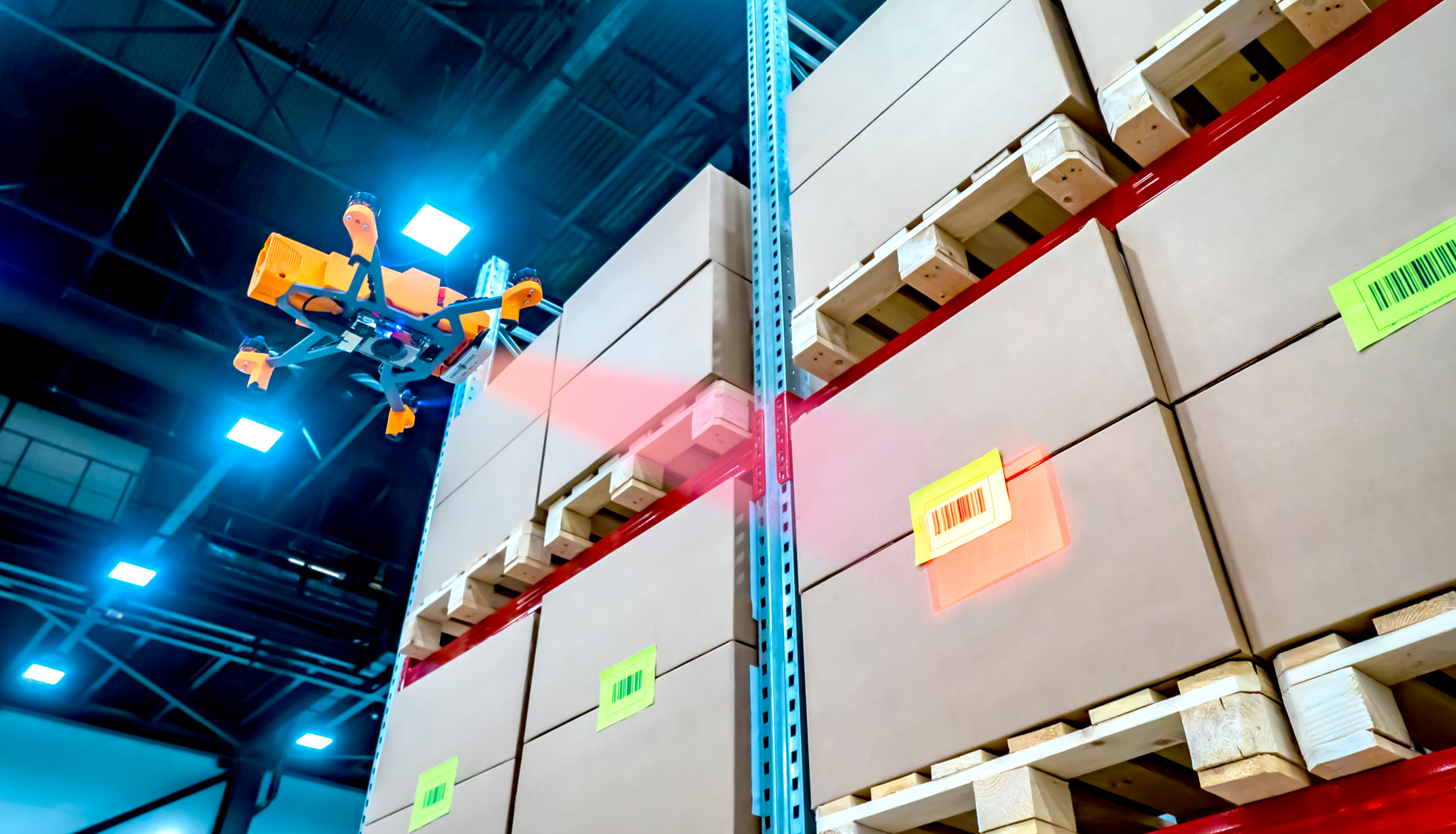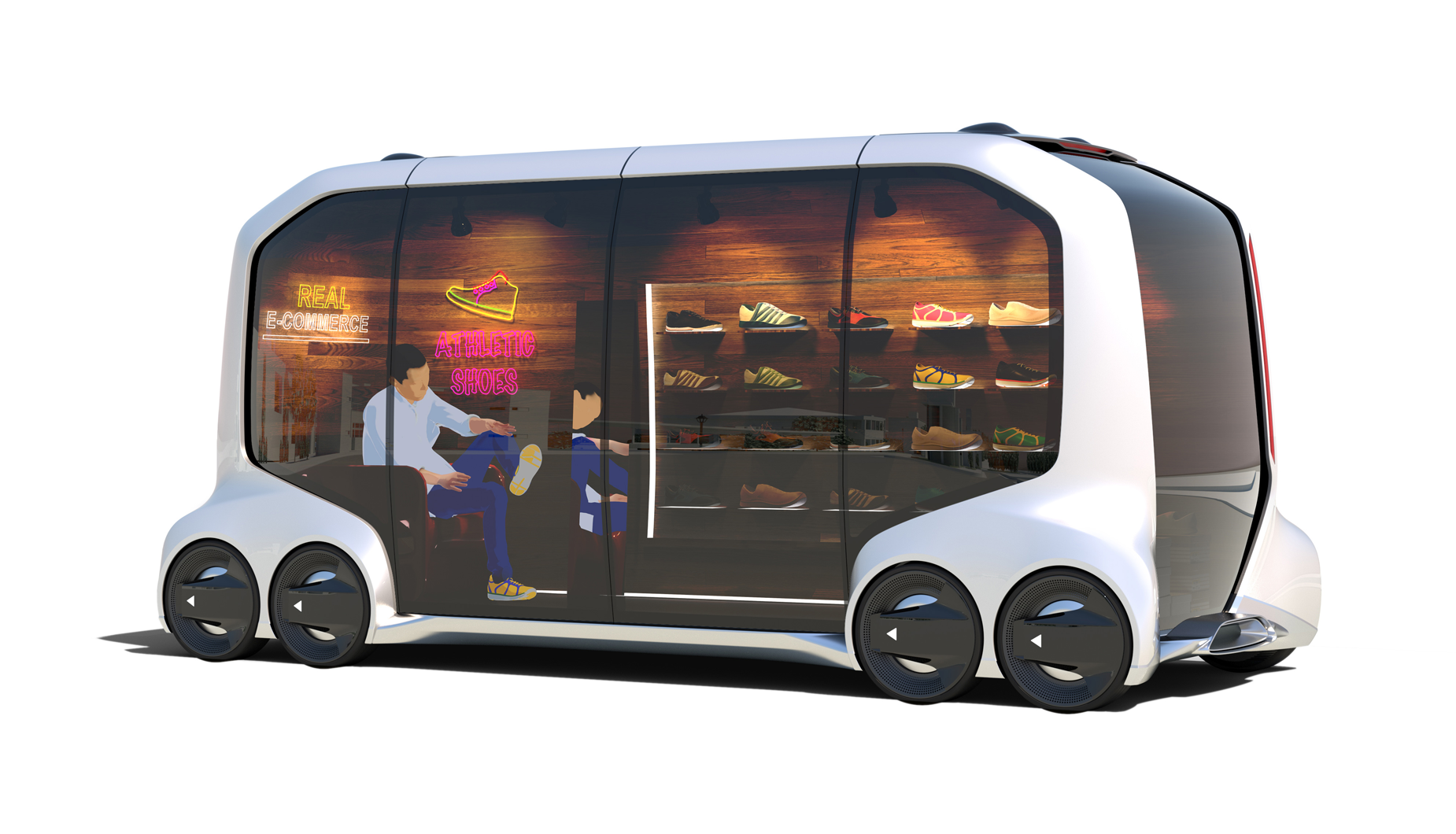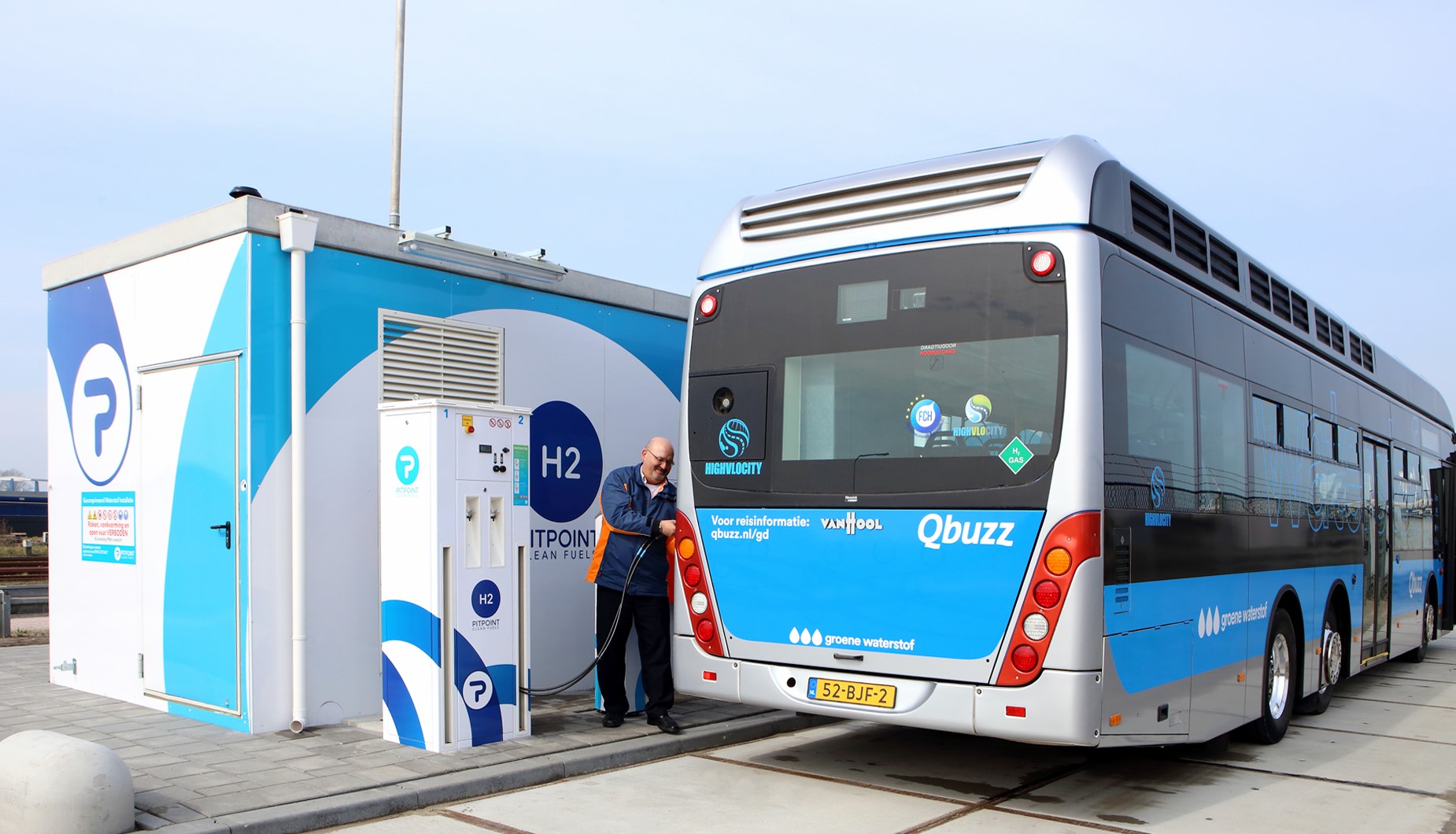What’s next for mobility?

From A to B is old news. In the future, smart operating and digital systems will make even more sustainable, effective and efficient mobility possible. Whether it’s the transportation of freight as part of the logistics sector, or public transportation in new innovative and sustainable forms; the future is already taking shape in the TopDutch region. Experts Prof. dr. Iris Vis, Dr. Janet Veldstra and Daniel Koelikamp explain what makes the TopDutch region, with its hive.mobility program, the ideal field lab for contributing to the design of the mobility of the future, within urban and rural environments.
Hydrogen buses, cargo bikes, drones, autonomous shuttle buses, trains and boats. In the future, the transportation of freight and people will be taking place within smart, sustainable and efficient networks. In the TopDutch region, hive.mobility is building an ecosystem that realizes this future. The region not only has the expertise, knowledge and pioneering entrepreneurs to realize this. It also has a unique mix of environment - dynamic cities surrounded by rural landscapes, an airport, seaport, a digital hub and the popular tourist hotspot; UNESCO world heritage site of the Wadden Islands – which makes it the ideal field lab to explore, test and implement mobility solutions that can help the world move forward.

Hive.mobility is a network organization founded by the Province of Groningen, City of Groningen, University of Groningen, Hanze University of Applied Sciences and Noorderpoort together with a large group of stakeholders in the region. Interdisciplinary research teams work in close collaboration with representatives of companies and government to develop, share and implement knowledge on the concept of sustainable and smart mobility.
We talked to some key members of the group: Professor dr. Iris Vis, Dean of Industry Relations and professor of Industrial Engineering at the University of Groningen; Dr. Janet Veldstra, Assistant Professor of Psychology and researcher and project co-lead of the SMiLES living lab in the hive.mobility network; and Daniel Koelikamp, Program Manager Smart & Green Mobility of the Province of Groningen explain how the TopDutch region is shaping the future of mobility.
Q. What are the major changes happening in the world of mobility?
Prof. dr. Vis: ‘With the introduction of new modes of transport and new concepts for sustainable transportation, new overarching visions for transport and logistics are being developed. The Dutch ‘Topsector Logistics’ – in which businesses, knowledge institutes and government work together in innovation programs – introduced, for example, the concept of synchromodal transport. Synchromodal transport allows for flexibility in selecting modes of transportation and delivery routes, resulting in more sustainable ways of performing logistics operations.
world of mobility?
Prof. dr. Vis: ‘With the introduction of new modes of transport and new concepts for sustainable transportation, new overarching visions for transport and logistics are being developed. The Dutch ‘Topsector Logistics’ – in which businesses, knowledge institutes and government work together in innovation programs – introduced, for example, the concept of synchromodal transport. Synchromodal transport allows for flexibility in selecting modes of transportation and delivery routes, resulting in more sustainable ways of performing logistics operations.
'Typically, in the traditional concept of logistics, routes, modalities and time schedules are determined upfront. Synchromodality, however, enables more real-time decision making. It might also allow for efficiently dealing with disturbances, such as the problem that occurred in 2011 when the European river Rhine became blocked by a vessel, resulting in a queue of over 400 vessels. Using synchromodal transport, the cargo on these ships could have been flexibly transported via different means of transportation – similar to how persons would rearrange their trip in case of a roadblock or a calamity.
'A second change is that concepts of the sharing economy also might apply in the world of logistics. Traditionally, each company has its own warehouse, its own mode of transport, and ensures themselves that goods will be transported from A to B. A next step in developing a more sustainable system for logistics and mobility can consist of the sharing of facilities, modes of transport and staff. As a third trend, we might expect that the networks for passenger and freight transport will be more connected in the future. Perhaps e-commerce lockers strategically placed at public transport hubs. All of these concepts are being studied and new tools and solutions are being designed in close collaboration between researchers, entrepreneurs, and representatives of companies and governmental organizations within the Topsector Logistics.’
Koelikamp: ‘In this region, for example, we’ve identified 55 interchanges, where at least three types of mobility come together – think of train stations, ports, airports, park & ride lots, and central or regional bus stations. These interchanges can be, via Mobility as a Service (MaaS), connected to each other, and thus through open and connected networks, can be transformed into hubs for passenger transport and parcel delivery. The point is that you can connect trains, buses, bikes, hubtaxis (a state-ran taxi service), and everything else that can transport people through one digital system. That system will provide the traveler or the sender of goods with the optimal route based on their pre-stated preferences: for example as fast, as sustainable or as cheap as possible. This offers, amongst other things, a lot of opportunities for efficiency in rural areas.’

Q. How does hive.mobility deal with these changes?
Koelikamp: ‘Hive.mobility is the name of an ecosystem, where initiatives to develop innovative mobility in the TopDutch region are encouraged. Educational institutions of all levels are involved, alongside local officials and entrepreneurs. One part of hive.mobility is a living lab called SMiLES, which stands for Shared Connectivity in Mobility and Logistics Enable Sustainability.
'The project partners focus on open logistics and mobility networks where key concepts from the sharing economy are at the center. The aim is to develop new knowledge and to test and validate the concepts designed. Key aspects to be studied are the role of new technology, behavioral aspects, ethical standards, legal frameworks and the development of revenue and organizational models within networks. In the project SMiLES a team of 16 researchers from 7 faculties in the University of Groningen and researchers from the Hanze University of Applied Sciences are working together with enterprises and governmental organizations. This includes the faculties of psychology, economics and business studies, spatial sciences, science and engineering, law, philosophy, and the interdisciplinary faculty Campus Fryslân.’
Veldstra: ‘Behavioral scientists deal with barriers and opportunities for the acceptance of these new innovations. In spatial sciences, it is about the relationship between the innovations and the environment. Economists and business researchers are developing new business models that can deliver the logistics and mobility concepts of the future, and engineers are working on models that can predict the reactions of actors in systems where knowledge is integrated. The nineteen business partners of SMiLES are regional and international experts in mobility solutions and services – wholesalers, distribution centers, carriers of goods and people, or digital studios. In addition to the University of Groningen, the Noorderpoort vocational college group and the Hanze University of Applied Sciences also launched learning communities. This creates an ecosystem that is capable of realizing innovation at both a scientific and a practical level, together with the business community.’
Hive.mobility is the name of an ecosystem, where initiatives to develop innovative mobility in the TopDutch region are encouraged.
Daniel Koelikamp, Program Manager of hive.mobility
Q. What will be the consequences of these changes?
Prof. dr. Vis: 'One of the main trends in logistics is what is called the physical internet: fully open and interconnected networks where resources can be shared, and freight can find efficient and sustainable ways from origin to destination. The concept of the physical internet was introduced by prof. Ben Montreuil, prof. Eric Ballot and prof. Russ Meller and is now broadly perceived as one of the new logistics paradigms.
'Using concepts of the sharing economy might contribute to reaching the point of zero emissions in freight transport. Real-time information on, for example, capacity of vessels, can be used to enable decision making on the specific mode of transportation to be used to deliver a parcel or the specific shared warehouse that can be used for temporarily storage. European Technology Platform ALICE (Alliance for Logistics Innovation through Collaboration in Europe) predicts that by 2030 this type of optimizing smart logistics will be the day-to-day reality to reduce the ecological footprint of transportation and logistics while keeping up high service levels.’
Koelikamp: ‘It also changes the way we see passenger transport. The public transport of the future will offer great new opportunities for entrepreneurs, in retail for example. The time people spend traveling can be used to do other things too. For example, they can eat in a mobile restaurant, or fit and purchase clothes in a mobile store. To this end, Toyota is currently developing a new concept, to be launched this year, called the Toyota E-Palette. This is a shuttlebus, where travelers can shop, dine out, or enjoy some other retail experience during their journey. Through data exchange they can tap into the passengers’ needs and wants and bring them together. This offers enormous opportunities for e-commerce businesses. For example, their customers can try-on their ordered clothes or footwear whilst traveling, which means they can cut down on dealing with returns. This can happen because the means of transport will no longer matter to the consumers in the future.’

Veldstra: ‘At the same time, I think traveling is also a way of expressing yourself. It’s usually assumed that people only make certain transport choices for practical reasons, but research shows that this is often not the case. Traveling isn’t simply a method of getting from A to B for some people; but also a way to express what they like or feel like. For example, traveling in your new Porsche is not practical, but it is fun. We may question to what extent people are willing to give up some of that fun for the sake of the safety and efficiency that autonomous driving brings. There are still many legal and moral frameworks that aren’t clear. Of course, there’s the complicated questions relating to liability in the event of an accident, but there’s many more. For example, the question of what travel behavior data one will be allowed to share with each other in the future.’
Q. Can you give examples of some projects that are bringing the future of mobility closer?
Koelikamp: ‘Take for example, the sustainability of mobility. The TopDutch region is leading in hydrogen-based mobility. There are 30 buses running on hydrogen here. In March 2020, there will also be a hydrogen train running. Entrepreneurs are building a network of hydrogen fueling stations. Also, drones will start flying on hydrogen and there are already cargo bikes using hydrogen. In addition, the TopDutch region is also a forerunner in digitalization. The region is one of the only in the world that has autonomous transport in all four modalities – road, rail, air and water. For example, patients in Scheemda, in the Province of Groningen, are transported to the hospital in a self-driving bus. Recently, in the TopDutch region, a semi-autonomous train transported passengers for the first time in Europe. Groningen Eelde airport is already flying autonomous delivery drones. And in Eemshaven there’s a project underway working on autonomous ships.’

Dr. Veldstra: ‘As scientific researchers, we want to be able to transfer theory into practice. We also want to learn to apply theory to the development of reality. At the University of Groningen, researchers have been working on the topic of mobility for a long time now - these researchers are now connected in a community through hive.mobility’.
Prof. dr. Vis: ‘Smart mobility is more than just a technological development. It’s also an ethical, social, anthropological and legal challenge. The knowledge and facilities to meet this challenge by studying smart mobility are centered here. The University of Groningen has a large group of researchers working in this field. Also at the Hanze University of Applied Sciences, NHL Stenden University of Applied Science, and the vocational colleges Noorderpoort and Alfa College, several groups are active in this field. With respect to the Physical Internet, we notice that several companies in the TopDutch region are contributing to developing technology platforms. Examples include Dropper, who are developing a smart platform for inner city logistics; mainly packages and fast food. And Vinturas, who uses blockchain technology in order to share information about transport goods in a better way.’

Q. Why is the TopDutch region a pioneer in mobility?
Prof. dr. Vis:‘The TopDutch region, with both metropolitan as well as rural areas and all major modes of transportation present, is an ideal area to serve as a field lab where cooperation is key in contributing to the development of the logistics system of the future. Together with partners in hive.mobility, an innovation agenda is being created to demonstrate our joint plans and efforts for knowledge development, application, pilots and implementation. Also, students of all educational levels will intensively participate in those activities through hive.mobility.’
Koelikamp: ‘This region is like the Netherlands in miniature. Here we have the fifth largest city in the Netherlands, surrounded by a rural area with small, declining populations. In that rural area, the challenge is to maintain the services. Traveling the last few miles to get to these remote areas is expensive. Building an operating system that combines transport journeys will offer great opportunities to make delivery more efficient. And linking the operating system for passenger transport with that for goods we can see even bigger opportunities. If regional buses can also be used as a means of transport for packages, then accessibility will be greater. We also see opportunities in projects with smart vehicles. In the TopDutch region we have a 5G lab, and added to digital hotspots like the ASTRON radio telescope in Drenthe, and the Google and QTS Data Centers in Eemshaven, the region is a digital knowledge hub.’
One of the main trends in logistics is what is called the physical internet: fully open and interconnected networks where resources can be shared, and freight can find efficient and sustainable ways from origin to destination.
Prof. dr. Iris Vis
Q. What should this bring in the future?
Prof. dr. Vis: ‘The development of the physical internet can support the movement of individual containers through the network in the smartest way possible, similarly to how the actual internet transfers data through small packages across internet servers. When one sends an email, the main focus is on creating the content of the message. Typically, a sender wants to be sure that the message arrives at the right recipient but, while sending the email, does not pose constraints on the route taken along the various servers. In the same sense one can consider that the sender and recipient of freight do not care about the route taken as long as it arrives in a sustainable way at the right time in the right quantity at the right quality.’
Dr. Veldsta: ‘The development of the physical internet raises all sorts of new questions. Take for example, the question of what information can you actually share. In order to optimally transport packages or people from A to B via autonomous networks in the future, this involves extensive exchanges of information. During this exchange, the ethical question comes up: What information can you actually ask people to share? That’s what University of Groningen philosophers and ethicists are working on. Another relevant question is: What are people willing to share? That’s a matter that the psychologists are concerned with. And then there’s the question about the possibilities of new technologies: How can they be modeled in an appropriate way? This is the sort of question that scientists from the faculty of Science and Engineering look at. Or what about the public space can you take up for transport? This is a question that our spatial scientists are concerned with.’
The development of the physical internet raises all sorts of new questions. Take for example, the question of what information can you actually share.
Dr. Janet Veldstra, Assistant Professor of Psychology and researcher at hive.mobility
Q. How will goods end up at the receiver in the future?
Prof. dr. Vis: ‘We note that there are currently different concepts being introduced and developed. Within the urban environment, for example, one can think of self-driving vans driving around to deliver parcels to a consumer’s house. Another option might be that a package is delivered to a locker at a hub for public transport and that the customer takes care of the last mile themselves by using public transportation.

‘As with the concept of synchromodal transportation, day-to-day decisions might be made for routes which require frequent supplies. For example, electric vans could be located at mini hubs in city centers that carry inventory for orders that can be expected to occur during the day in that area. Alternative fuels such as hydrogen or bio LNG is also an important area of expertise in the TopDutch region. We also already see a comparatively large number of hydrogen buses and cars driving around here. The logistics platforms of the future are already developing – they’re popping up in the market left, right and center. For enterprises, it is important to think about how to keep adding value in this changing world of logistics.’
Koelikamp: ‘The future of mobility is three-dimensional. Autonomous drones will move people from hub to hub. Packages will also be delivered by drones. They’ll be used more often over long distances too, such as over the sea. Technology is developing at lightning speed. As a result of the four Wadden Islands being located in the TopDutch region, there are excellent opportunities for us to experiment with such modalities. And don't forget the opportunities with the Hyperloop, which fits perfectly with the work we are doing here in the TopDutch region in the field of autonomous and zero emission transport of people and goods. The European Hyperloop Test Center will be opened in the TopDutch region. The instigator Hardt Hyperloop chose to locate in this region because of the fitting ecosystem, and because of the culture and experience of collaboration between companies, governments and knowledge institutions.’
Q. Why should companies settle in the TopDutch region?
Koelikamp: ‘In the TopDutch region, there’s a large ecosystem of top logistics companies. Valuable additions to that would be companies that can do something to make the connection between the city and the countryside smoother, that want to work together intensively with other local players to apply our expertise.’
Hive.mobility
Hive.mobility is a knowledge platform where researchers, company and governmental representatives work together to develop smart, sustainable and innovative mobility solutions that can be applied in the north of the Netherlands and beyond. Hive.mobility is located at Campus Groningen.
The key issues of hive.mobility include:
- Smart logistics for cities and countryside;
- Open and connected network for goods and passenger transport (such as hubs and the ‘Mobility as a Service, MaaS’ concept);
- Improving sustainability of mobility and infrastructure;
- Autonomous transport via land, water, rails and air
- Smart networks (communication between vehicles in a network, 5G, data sharing).
SMiLES is part of the research program Sustainable Living Labs, which is co-financed by the Dutch Research Council (NWO), the Ministry of Infrastructure and Water Management, Taskforce for Applied Research (SIA) and the Top Sector Logistics.
Join TopDutch
So what will be your next move? What role will your company play in developing the next operating system for logistics? Contact our network of knowledge-intensive institutions and innovative and entrepreneurial companies. You’ll soon see for yourself how quickly things get done here in the Northern Netherlands.
Subscribe to the newsfeed
TopDutch Logistics Package
Get your hands on:
- - Unlimited access toTopDutch Logistics articles
- - The most exclusive investment updates, industry insights and key stories from our key industries
- - Invites to exclusive international industry events and meet-ups
Contactform
"*" indicates required fields
